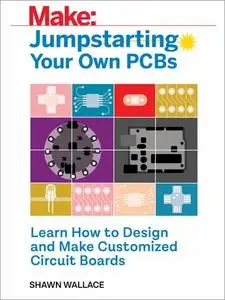Jumpstarting Your Own PCB: Learn How to Design and Make Customized Circuit Boards by Shawn Wallace
2018 | ISBN: 1680455125 | English | 50 pages | EPUB/MOBI | 18 MB/10 MB
2018 | ISBN: 1680455125 | English | 50 pages | EPUB/MOBI | 18 MB/10 MB
Autodesk EAGLE (Easily Applicable Graphical Layout Editor) is a collection of programs, each serving one part of the design process. We’ll focus on the Schematic Editor and the Board Editor; other EAGLE modules include Autorouter (which uses a simple AI to trace circuit routes), the Parts Editor, the CAM Processor (for creating machining-ready files), and a scripting interface for writing user language programs (ULPs). This chapter is a quick overview of the tools we’ll be using to create three different electronics projects in later chapters.
Designing a circuit board is not difficult but has some challenges specific to the application area that make having an electronic design automation (EDA) tool particularly useful. EAGLE offers a few advantages over a non-EDA design tool:
Visualizing connections: Multisided PCBs can have components on different sides and traces that zigzag between layers.
Hierarchical and parametric design: You should be able to make designs that can inherit properties from modules and be customized using data.
Libraries: Electronics components come in a dizzying range of packages and variations; tools for managing and organizing devices are critical.
Design rules: You can specify constraints and test your design against them.
Another important consideration is how the electronics designer fits into a larger product development cycle. Many EDA tools are now offering closer integration with CAD tools—for example, Altium and SolidWorks, or EAGLE and Autodesk Fusion 360.



